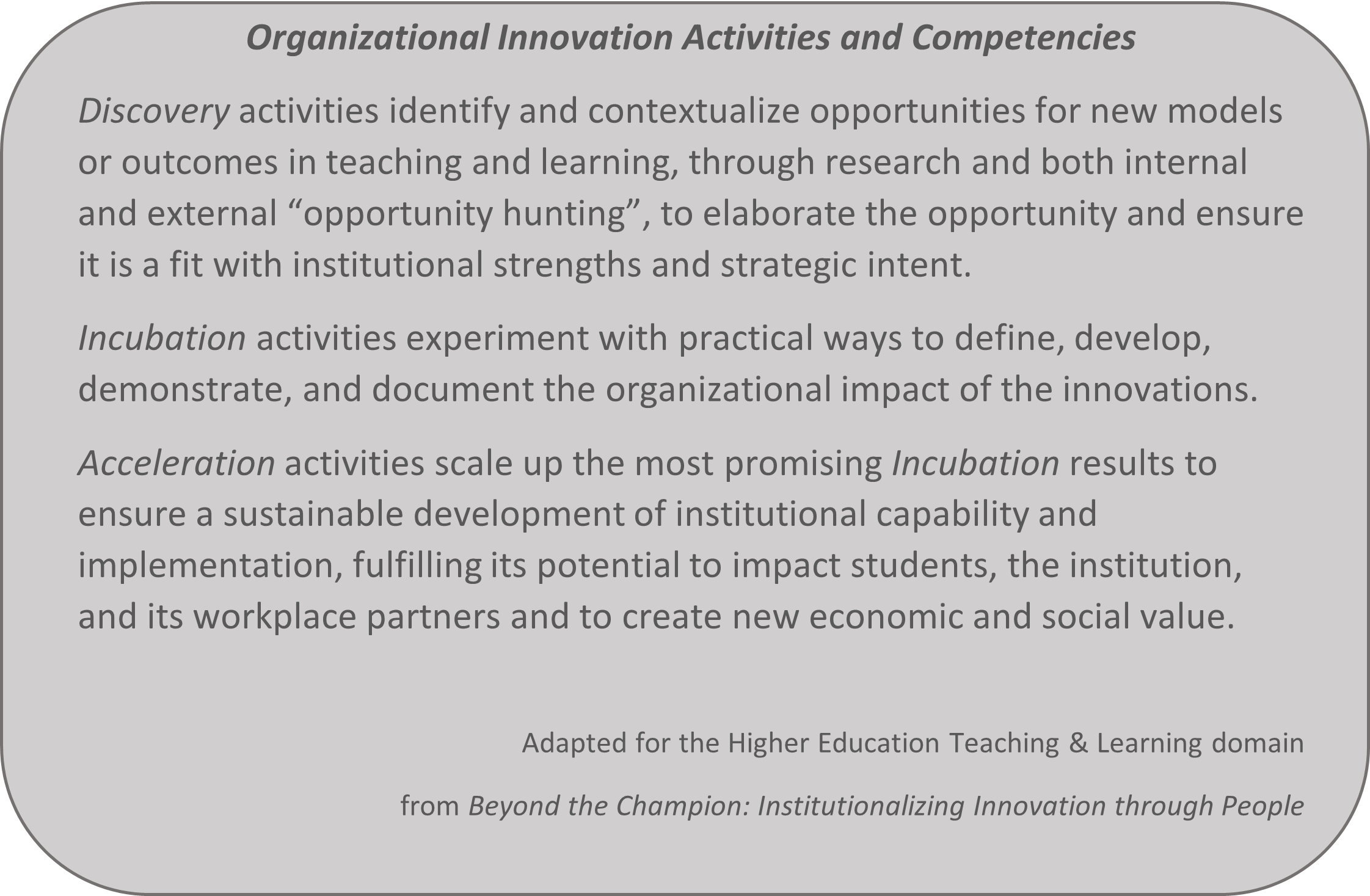Anahita Baregheh is an Associate Professor at Nipissing University’s School of Business and Research Director for the Workplace Innovation Network for Canada.
Thomas Carey is co-Principal Catalyst for the Workplace Innovation Network for Canada, Executive-in-Residence with the Monash University Faculty of Arts and a former Associate Vice-President at the University of Waterloo
In our previous WiNCan posts on the Sustaining Strategic Innovation in Higher Education project, we described some of the insights from a series of research studies on strategic innovation in the corporate sector and our use of scenario prototypes to experiment with adaptation of those insights for strategic innovation in Higher Education teaching and learning.
Our development of the scenario cases highlighted two key differences in the significance of Discovery, Incubation and Acceleration competencies for strategic innovation in Higher Education Teaching & Learning (HETL) versus corporate sector organizations. This post contains our preliminary reflections on one of those differences, as revealed in our scenario development.
Open Sharing of Innovation Insights in Higher Education
Activities in these three areas and the resulting insights are not regarded as in-house confidential in HETL to anything like the same degree as would be true within the corporate partners.
As a result, institutions that focus on Acceleration competencies could still achieve strategic distinction in their markets, e.g., a region-serving institution could be behind global leaders engaged in Discovery and Incubation and still be a leader in its regional market in implementing radical innovations within its programs, by excelling in strategic foresight about those developments elsewhere and in absorptive capacity to adapt them quickly within its programs. (We’re currently consulting with one such institution, where thinking along these lines has proved to be useful in their planning…more on that in our next post).
The opportunity to focus only on some of the competencies applied in the corporate sector seems to us to be critical for region-serving institutions like the one described in our Heartland State scenario:
their current understanding of strategic innovation is at an early stage, and
their current strategic distinction lies in their leading-edge infrastructure -- knowledge, technology and social capital -- to develop, demonstrate and document graduate attributes by integrating learning outcomes and learning experiences across curricular and co-curricular opportunities.
The folks at Heartland – as at many of our higher education institutions – don’t have a track record of excelling in Discovery through defining new outcomes; while they have done a fair amount of Incubation in developing new learning experiences, some of that could have leveraged more Incubation work elsewhere to shorten their time-to-market.
On the other hand, in the proposed “startup university” in the Greenfields scenario, the Return-On-Investment case for the city and region comes from new inbound investment to create jobs for city residents and subsequent commercial/industrial tax revenues. The "region-serving" mission for Greenfields thus extends beyond serving current learning needs of the region and requires strategic excellence at a broader level in anticipating future learning needs…and helping the regional workforce to get a head start on them.
This appears to require that Greenfields excel in Acceleration – perhaps by emulating Heartland State – and also gain recognition for strategic leadership in aspects of Discovery and Incubation (i.e., “we're staying on top of emerging work requirements to enable our local workforce to excel in work-readiness...both for entry-level graduates and to support ongoing development of your employees”).
In Part II of this blog post, we’ll explore an additional difference we noted in the way Discovery, Incubation and Acceleration activities occur in higher education institutions (versus corporate sector organizations): the challenge of rapid prototyping cycles for higher education programs. We’ll also outline how we have been applying the Discovery-Incubation-Acceleration framework to inform ongoing academic planning with another region-serving institution.



